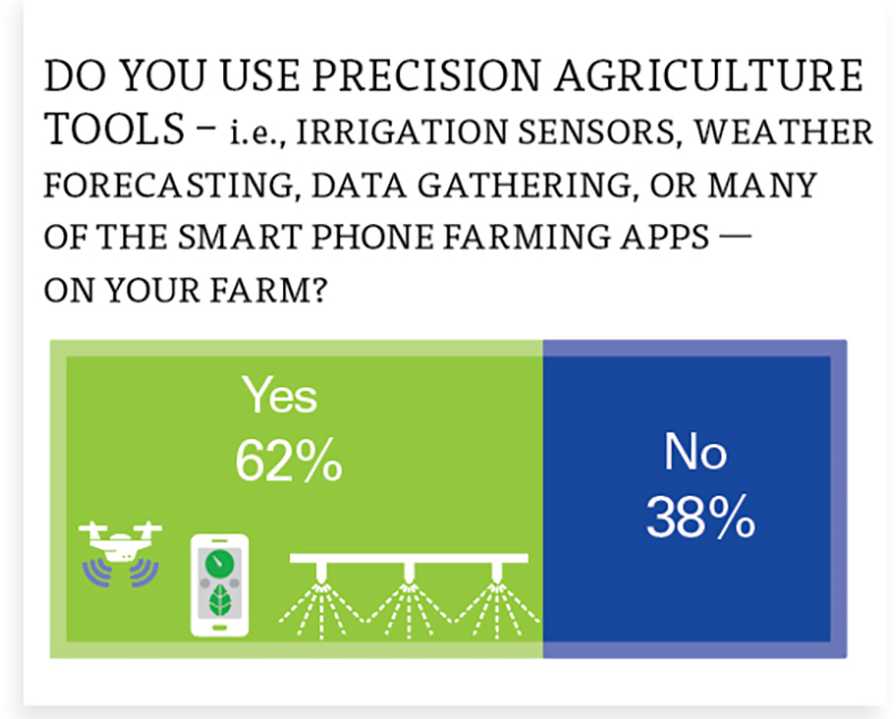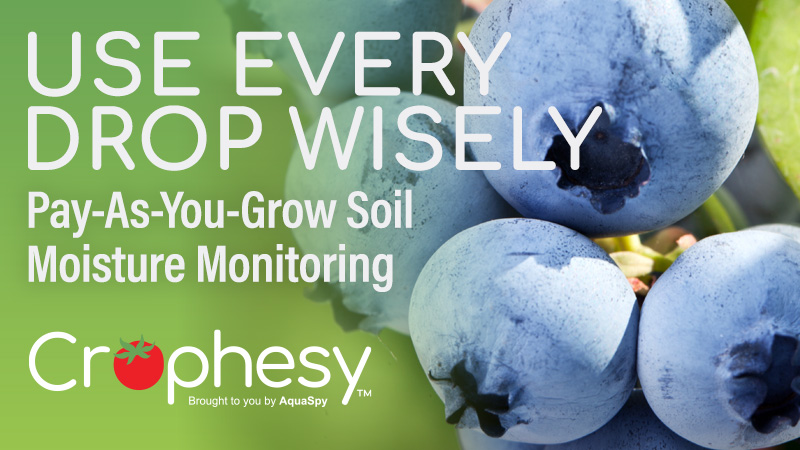Precision Ag Use on the Rise With More Fruit Growers
More growers continue to adopt precision agriculture tools, according to American Fruit Grower® and Western Fruit Grower® magazines’ 2021 State of the Industry survey. In last year’s survey, 56% of growers reported using precision agriculture tools — from arrays of sensors all the way down to smartphone apps — but that number has climbed to 62% in this year’s survey.
“To be competitive in this industry, you need to have as much information as possible available to your operation to make critical decisions,” says one grower. “Cutting inputs can only be done if you measure and know what you have. Precision technologies help us to fill knowledge gaps.”
Perhaps no grower sums up the situation so comprehensively. Others are pithier: “Cost of not using,” says one. “Just to have a good product to sell,” says another. “It helps to do a better job,” states another simply. Or this enthusiastic grower: “Knowledge is power. I know something my competitor doesn’t — I am stronger!”
Some growers remain dubious about the technology, although perhaps reflecting the increasing usage, there are far fewer negative comments this year from growers. Here’s a representative comment from one such grower: “The costs of implementing new technologies is a high hurdle. It is very expensive to employ the new technologies, and it takes time to get the returns on the investment.”
Still others are a little more colorful, such as one grower who says they are “looking for ways to improve. (But) not happy nor satisfied so far. A lot of hype, not much bite.” Another adds that their experience has been “only negative: Most technology is overrated, time-consuming, and not cost-effective. Lots of bell noise and whistle clutter.”
But few of those down on the technology have no problem with the technology itself. The overwhelming comment from those not adopting is that they are simply too small. “My operation is too small (1.13 acres of fruit) to justify the cost, and I am not really good with smartphones or computers,” says one grower, adding “our county is thinly populated, and help on this may be difficult to find.”
On the other hand, growers reporting use of technology have a wide range of reasons. Most have to do with cutting costs, such as being more efficient in the use of labor. But reducing the amount of materials used on the farm is by far the biggest, with grower comments ranging from “more precise crop inputs,” to “insect cycling forecast modeling,” to “timing sprays for changing weather conditions,” to “not wasting fuel and chemicals.”
Without further ado, here are the answers, straight from the growers, to two of the questions on precision agriculture tools asked in this year’s State of the Industry survey.
What was the driver to implement precision agriculture technology, (e.g., labor concerns, more precise crop input application, a desire to be on the cutting edge)?
- “To know better what to expect and what we can do to improve the farm.”
- “More precise crop information and management and a desire to be on [the] cutting edge.”
- “Desire to understand what is happening and respond rationally.”
- “Irrigation was used because of the possibility of a drought. Weather forecasting and data gathering so I could be aware of the best time to plant and the best time to cultivate crops.”
- “Mostly crop protection: modeling for insects and mildew infections, and weather stations for frost controls.”
- “We use sensors for better data gathering, which helps us for trending and things like pest models for pesticide application. Would like to use more tech, but outside of DIY solutions we have built with low-cost sensors, we are usually priced out or find the solutions lacking. We also have a lack of reliable internet and cellular on the farm, which prevents us from using many solutions.”
- “Desire for detailed data analysis and improved tracking of field activities.”
- “Simply efficiency and management of resources.”
- “The need to be informed about the weather more precisely and record crop inputs.”
- “Apple-thinning models, irrigation models.”
- “Irrigation sensors, water meters, winery requirement to implement sustainability program.”
- “Implement additional soil-building products. It all starts with good soil nutrients stored in the soil. Building on this yearly!”
- “Have used sensors for many years. Forecasts are more helpful than in years past.”
- “Price of spray materials, [which are] going to put crop growers out of business.”
- “More precise crop input. This is my first year farming after my parents were leasing [the] farm to [a] neighbor who was running it into the ground. Water for 12 hours once a week, regardless of the soil. I knew the sandier soils needed more. I bought a weather station and two probes to look at the two predominant soil types in the area. The sandier soils showed a water deficit every 3 to 4 days, depending on the temperature.”
Aside from cost, why have you not implemented precision agriculture on your farm?
- “The many, many fruit visualizing and counting tools don’t help me as a grower. They count too late. I need something to see fruitlets at petal fall and then during chemical thinning.”
- “Some tools can gather lots of data, but the applicability of that data to make business decisions is sometimes not there.”
- “Trying to find the true value in implementation. Does the fine-tuning actually produce a quantifiable difference in quality or return?”
- “We implement the technologies that help us make critical decisions, not just because they are cool. Operational size limits some technologies because of cost or technologies that are not very user friendly.”
- “Difficult to decide what technologies are credible. There are so many salesmen pushing their products that it is difficult to say what is the best for our applications.”
- “Don’t need it, just something else that takes money from the crop.”
- “I seek to have an operation off the grid and independent of tech.”
- “We are a smaller operation and can get the readings we need from hands-on efforts. I think many of the precision agriculture tools are amazing, though, and would consider using some of them in the future.”
- “I have not seen a precision ag tool that has proven itself economically viable yet.”
- “Not as easy to use or needed on a very diversified market farm with a lot of different crops grown in small amounts in several plantings, not enough time in the day, internet service issues.”
- “Needs payback and reliability. All this new stuff breaks down.”
- “I have a very small commercial vineyard, so the expenditure for precision ag stuff is not cost-justified.”
- “The irony is as we move toward technology, we lose sight of nature. We try to be as holistic and in tune with nature as possible.”
- “Labor, by far, is my number one cost. Nothing so far applies in a material way.”
- “Most of my production is highly diverse and small scale, which makes the application much tougher.”
- “Most practices have to have time to be tested before I would rely on them.”
- “Because I am working toward a human future and not a future of AI (artificial intelligence) control of humanity.”











